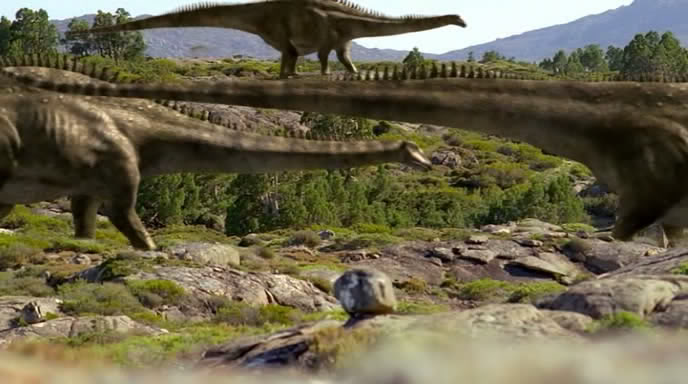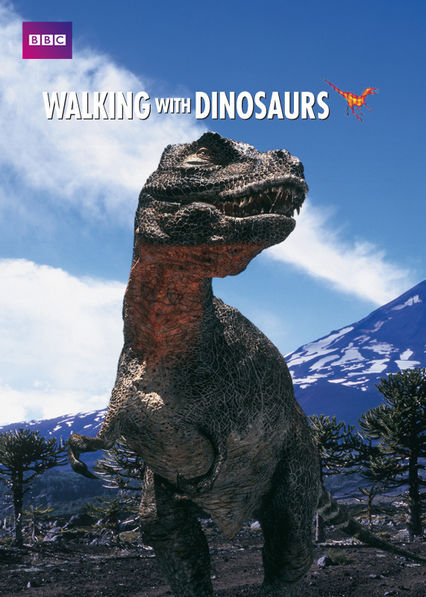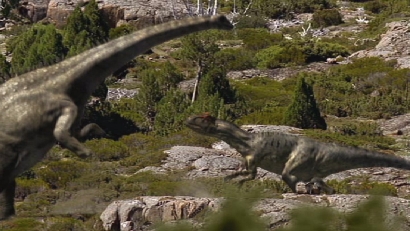Walking With Dinosaurs: Time of the Titans is a 1999 BBC animated documentary that brought together paleontologists and animators alike with the aim of bringing the age of dinosaurs to life, giving the audience a feeling of what it was like when dinosaurs roamed the earth. This particular episode is part two of a six episode set following the evolution and extinction of dinosaurs. Time of the Titans follows a young female Diplodocus, in the Jurassic period, through her life cycle, replicating the cyclic feeling that Disney brought to wildlife film narration with their True-Life Adventures (28).[1]
The audience watches as the young dinosaur fights for survival, following her instincts. She faces many challenges throughout the 29 minute episode including predators, forest fires, and other hazards, but eventually she joins a heard and becomes a mother herself, bringing the story full circle. The use of animation to create a prehistorical, nonfiction nature film was a style director Tim Haines had no choice but to use given that his chosen species has been extinct for millions of years. However, through the use of film and camera creativity, the team was able to create a film that was enthusiastically accepted by scientists and the general population alike. The skills used incorporated the wildlife film style typical of many nature “documentaries,” also bringing into question the scientific versus entertainment aspects of the film’s portrayal. Yet the film reflects the fascination that humans find with dinosaurs, creating a long-awaited visual work of art.
An animated documentary is defined as “a nonfiction film that uses animation as a means of visual representation.”[2] In Walking With Dinosaurs, the film crew used an animated documentary style known as “mimetric animation.” This style of animation is used when conventional material (such as camera footage and photographs) are impossible to find, falling into the nature film versus documentary dilemma that Derek Bouse brings up in Wildlife Films.[3] The issue with this style of animation, though it is the only way of portraying dinosaurs, is that the events that took place came before cameras existed. Thus, the filmmakers try their best to resemble reality, but there will always be speculation about the accuracy of the information portrayed in the film. This style does, however, allow the viewer to imagine themselves in the world being represented on the television screen, the exact intentions of Walking With Dinosaurs filmmakers.[2] The process behind making Walking With Dinosaurs was an elaborate one, as the paleontologists and animators attempted to create this fascinating world of dinosaurs as accurately as possible.
The animation of this film was handled by the British firm FrameStore.[4] Animation with the use of CGI was the dominant form of the film as when the filmmakers approached the animatronics developers of Jurassic Park they were told it would cost $10,000 per second, not an affordable budget for Walking With Dinosaurs. So, the crew started by finding places that would resemble the ecosystems of these time periods, including the redwood forests of California and New Zealand, and incorporating a sleight-of-hand photographic technique to make it look timeless. They used an anamorphic lens in order to “future proof” the film, filming the entire show in the format of a 16:9 HDTV and then resizing it to a 4:3 TV format. This allows for wide screen shots that are stretched and morphed to fit the screen, creating the look the filmmakers were looking for. A “lighting ball” was used in the animation process as well, a virtual camera with set position, so that they could understand the proper orientation and intensity of the sun and specific scenes, bringing the landscape as close to reality as possible.[4]
When it came to the dinosaurs themselves the filmmakers had to stray a bit further from scientific accuracy than originally planned.[4] When it came to the skin of the dinosaurs, something paleontologists have not found preserved, some scientific guesswork occurred. Originally the skin texture and color was based off of fossil impressions and the dinosaurs’ habitats and lifestyles, incorporating the idea that larger animals have duller skin colors. However, in order to make the scale structure show up on the television screen the animators hadto make them “reasonably large,” a compromise on accuracy in order for the film to look the way they wanted it to look. Then, when it came to the movement of the dinosaurs (another unknown aspect) the filmmakers looked to skeletal structure as well as observations of modern living animals including elephants. However, some dinosaurs proved to be harder to guess at than others. The Anurognathus was a flying dinosaur with a skeletal structure that made it difficult to guess at land movement. Thus, the film crew examined a man on four crutches while paleontologists looked on to come up with a possibly realistic idea of how the animal moved. These guesses did account for realistic-looking movement on screen to audiences, incorporating a new camera angle of the Diplodocus walking over the camera, a technique that took animators one hour per frame to master.[4] The combination of animation, puppets, and camera angles created a convincing documentary, however this did lead to the common mistake made with most nature films: that it is thought to be more accurate than it truly is.[3]
The film focuses on portraying historical findings paleontologists had uncovered while also providing an entertaining and action-packed narrative. Critics found the documentary to be “breathtaking” as the animators brought skeletons and fossils to life (ScaryMinds.com).[5] There may be some question, however, of how educational the documentary truly is. As mentioned earlier, in making the film paleontologists and animators collaborated to try and create a realistic idea of how dinosaurs would have looked, sounded, behaved, and moved as well as what their habitats would have looked like. This animation led paleontologists to write new chapters on dinosaur movement, yet the filmmakers admitted that accuracy was often compromised for entertainment and aesthetic purposes. It was also reviewed, at the time it came out, as being the “most incredibly accurate depiction of dinosaur life ever produced,”4 giving the false sense that every detail of the film was accurate to scientists’ knowledge. Throughout the film the narrator, Kennth Branagh, a British actor used to narrate many films after Walking With Dinosaurs, is used perhaps inappropriately to create the wildlife film feel, providing information about the animals. He states dinosaur “facts” as though they were true, despite the guesswork the crew was attempting, making it unclear to the audience that these “facts” were still, as yet, unknown.[6]This results in the film being perceived as educational, when in reality it would most likely fit better under the category of “entertainment.” Despite the fact that actual research was involved in the making of the film, there were too many unknowns for this to be an entirely educational film, calling into question the style with which the film was presented.
The film follows a typical wildlife film form, incorporating narrative and anthropomorphism, using words such as “she,” and “thief,” and “mother,” but does not give the young Diplodocus a name. There are many dangers thrown in, especially those of the predator-prey relationship, including an encounter with an Allosaurus. Two Allosaurus’ are featured throughout the episode, keeping a dangerous eye on the Diplodocus as she ages, and eventually attacking her as a pregnant young adult when she strays too far from the heard for a drink of water. Luckily enough, to keep the story upbeat as the audience has followed the young dinosaur’s story too long to watch her fall into the clutches of danger and mortal peril, she is rescued by another adult Diplodocus, though she does sustain some injuries for dramatic effect. The film also jumps from one location to the next, using time lapse techniques, and making it appear as though these slow moving animals travel faster than they did. Some relationships between dinosaurs are also addressed, as with the Anurognathus, a small flying dinosaur that feeds off of the insects that take shelter on the skin of the Diplodocus. Despite this being a small scene there are many facts thrown at the audience about the importance of this relationship for both dinosaurs as one is relieved of a burden and the other is sustained. However, as critics have mentioned, later research found that the two species, in fact, did not even live in the same country and most likely never had any interaction (ScaryMinds.com).5 Despite all of this, however, the filmmakers still strived to make a dinosaur film as realistic and accurate as they could, providing audiences with a never-before-seen view of what life was like millions of years ago and portraying a species that, curiously, has been a topic of fascination for human beings since their discovery in the 1800s.[7]
W.J.T. Mitchell, author of The Last Dinosaur Story, attempts to explain the fascination that humans have pertaining to dinosaurs. He believes that dinosaurs are a symptom of “the political unconscious.”[7] This implies that dinosaurs are indirectly representing the changing economic forces in modern day society and culture. Mitchell uses psychology to ground his idea that these creatures represent a “totem of modernity.” They are a symbol of the modern world. They are seen as a hybrid character that is both historical truth and mythological fantasy, allowing them to be thought of and viewed as both “science and fantasy, nature, and culture, the image of the other and the image of the self.”[7] Whether Mitchell’s theory is correct or not, however, there is no denying that dinosaurs have been and remain to be creatures that people like and want to learn more and more about. This interest in dinosaurs and a desire to know what their world was like is what led Tim Haines and his team to make Walking With Dinosaurs and is the reason why they went to such great lengths to make the film as realistic as possible.[6]
Walking With Dinosaurs: Time of the Titans is a strategically timeless nature film that utilizes animation and modern day camera techniques in order to bring to life dinosaurs, a species that went extinct millions of years ago yet continues to capture the interest of scientists and audiences alike. Although this was not the first dinosaur documentary, it was the first to try and bring dinosaurs to life as realistically as possible, the result being a remarkable film providing the audience with at least an idea of what the world used to look like and of the animals that so much of today’s life has evolved from.[3]
[1] Chris, Cynthia, Watching Wildlife (Minneapolis: University of Minnesota, 2006)
[2] Marcus, Daniel & Kara, Selmin, Contemporary Documentary, (New York: Taylor & Francis
Books, 2016)
[3] Bouse, Derek. Wildlife Films. Philadelphia: University of Pennsylvania Press, 2000. Print.
[4] Huelsman, Eric. “Walking With Dinosaurs.” Technology Prodcution 22.1 (2000): 1-6. Web.
4 October 2016.
[5] Making of Walking With Dinosaurs. Dir. Jasper James. Perf. Kenneth Branagh, Andrew Dutty, and Marco Marenghi. 1999. Internet Archive. Web. 13 September 2016.
[6] “ScaryMinds Review Of Walking With Dinosaurs Episode 2.” ScaryMinds, 2012, http://www.scaryminds.com/reviews/2012/walkingwithdinosaurs2.php. Accessed 13 September 2016.
[7] Taylor, Mark. “Heavy Symbolism: Does the dinosaur stand for our collective political unconscious?” New York Times. New York Times, 25 Oct. 1998. Web. 4 October 2016.
Walking With Dinosaurs: Time of the Titans. Dir. Tim Haines and Jasper James. Perf. Kenneth Branagh. 1999



